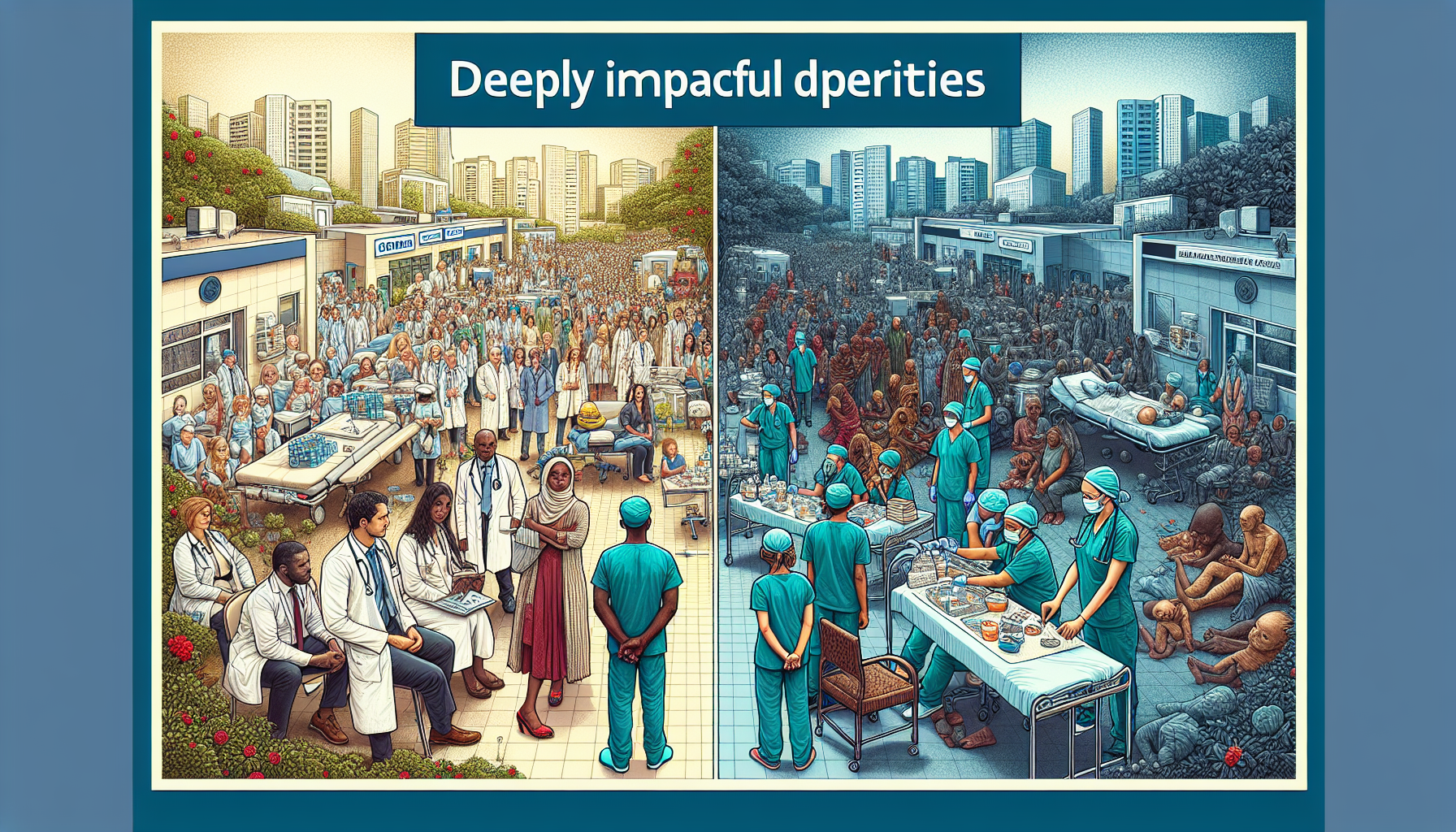In this article, we will explore the fascinating topic of healthcare in the US and how it compares to other countries around the world. We’ll examine the differences and similarities, taking into account factors such as cost, accessibility, and quality of care. Join us on this enlightening journey as we uncover the intricacies of healthcare systems and gain a deeper understanding of how the US measures up to its international counterparts.

Quality of healthcare
Medical infrastructure
The quality of healthcare in a country is dependent on various factors, one of which is the availability of a robust medical infrastructure. Medical infrastructure includes facilities such as hospitals, clinics, and medical equipment. In the United States, the medical infrastructure is highly developed with state-of-the-art hospitals and advanced medical technology. These facilities are equipped with the latest medical devices and equipment, enabling healthcare professionals to provide accurate diagnoses and effective treatments. The well-maintained infrastructure allows for efficient care delivery and ensures that patients have access to a wide range of medical services.
Availability of medical professionals
Another crucial aspect of healthcare quality is the availability of medical professionals. The United States is known for its highly skilled and specialized healthcare workforce. The country attracts a large number of talented doctors, nurses, and specialists from around the world. This ensures that patients have access to a diverse and knowledgeable pool of medical professionals who can effectively address their healthcare needs. Furthermore, the continuous education and training opportunities available in the US healthcare system contribute to the high level of expertise and competence demonstrated by its medical professionals.
Technological advancements
Technological advancements have significantly impacted the quality of healthcare globally, and the United States is at the forefront of these advancements. The country invests heavily in research and development, leading to the development and adoption of groundbreaking technologies in the healthcare sector. From advanced medical imaging techniques to robotic surgeries, the US healthcare system continually embraces technological innovations to improve patient outcomes. These advancements not only enhance the accuracy and efficiency of medical procedures but also contribute to the overall quality and safety of healthcare delivery.
Rates of preventable deaths
The rates of preventable deaths serve as an important indicator of healthcare quality. Preventable deaths refer to deaths that could have been avoided through timely and appropriate healthcare interventions. While the United States has made significant progress in reducing preventable deaths in recent years, there are still areas of concern. In comparison to other developed countries, the US has higher rates of preventable deaths, indicating potential gaps in healthcare quality. Addressing preventable deaths requires a comprehensive approach that includes improved access to primary care, better coordination of care, and enhanced patient education.
Healthcare accessibility
Healthcare coverage
Healthcare coverage plays a vital role in ensuring that individuals can access necessary medical services without incurring significant financial burdens. In the United States, healthcare coverage is a complex and multifaceted issue. While the country has implemented programs like Medicare and Medicaid to provide coverage to specific populations, a significant portion of the population still remains uninsured or underinsured. This lack of universal healthcare coverage has led to challenges in accessing timely and affordable healthcare services for many Americans.
Wait times for medical care
Wait times for medical care are another important consideration when assessing healthcare accessibility. In the United States, excessive wait times for appointments with specialists or for certain medical procedures are not uncommon. This can lead to delays in diagnosis and treatment, potentially impacting patient outcomes. The reasons for long wait times in the US healthcare system vary, but factors such as a shortage of healthcare professionals, high demand, and the complexity of administrative processes can contribute to these delays. Improving access to timely care requires addressing these underlying factors and implementing strategies to reduce wait times.
Geographical accessibility
Geographical accessibility is a critical aspect of healthcare accessibility, particularly in large and diverse countries like the United States. Access to healthcare services can be challenging for individuals living in rural or remote areas, where medical facilities may be limited or far away. In these areas, the lack of proximity to healthcare providers can result in delayed or inadequate care. Additionally, transportation barriers and limited healthcare infrastructure in certain regions can further exacerbate healthcare disparities. Efforts to improve geographical accessibility involve expanding healthcare facilities and implementing telehealth services to bridge the gap between patients and healthcare providers.
Affordability
Affordability is a significant factor affecting healthcare accessibility in the United States. The high cost of healthcare services and treatments can be a barrier for many individuals, especially those without comprehensive insurance coverage. Out-of-pocket expenses, such as deductibles, copayments, and uncovered services, can quickly accumulate, leading some to forgo necessary medical care. The affordability challenge is further heightened by the rising cost of prescription drugs, which can place a significant financial burden on patients. Addressing affordability requires comprehensive healthcare reforms aimed at reducing costs and ensuring equitable access to affordable care for all individuals.
Healthcare cost
Overall healthcare expenditure
The United States consistently ranks among the highest in terms of overall healthcare expenditure globally. The country’s healthcare system accounts for a significant portion of its gross domestic product (GDP). High healthcare expenditure can be attributed to various factors, including the high cost of medical treatments and services, administrative complexity, and the prevalence of chronic diseases. While the US healthcare system provides world-class care, this high level of expenditure raises questions about the sustainability and efficiency of the system.
Healthcare spending per capita
When comparing healthcare systems between countries, healthcare spending per capita is an important metric to consider. The United States often leads in healthcare spending per capita, investing significantly more than many other developed nations. Despite this substantial investment, healthcare outcomes in terms of life expectancy and overall health remain lower compared to countries with similar levels of expenditure. Analyzing healthcare spending per capita helps assess the efficiency of healthcare systems and the effectiveness of resource allocation.
Out-of-pocket expenses
Out-of-pocket expenses refer to the portion of healthcare costs that individuals must pay directly from their own funds. In the United States, out-of-pocket expenses can be a significant burden for patients, particularly for those without comprehensive insurance coverage. These expenses include deductibles, copayments, and coinsurance, among others. The high out-of-pocket costs in the US can deter individuals from seeking necessary medical care, leading to delayed or inadequate treatment. Finding ways to alleviate the financial burden of out-of-pocket expenses is crucial to improving healthcare affordability and accessibility for all Americans.
Pharmaceutical costs
Pharmaceutical costs in the United States are often a topic of debate and concern. The high prices of prescription drugs have resulted in affordability challenges for many patients. Compared to other developed countries, the United States often experiences higher drug prices due to variations in pricing regulations and negotiations between pharmaceutical companies and payers. The impact of high pharmaceutical costs on patients can be significant, forcing some to make difficult choices between purchasing necessary medications and meeting other essential needs. Exploring strategies to regulate and reduce pharmaceutical costs is essential to improving healthcare affordability and ensuring access to vital medications for all Americans.
Healthcare outcomes
Life expectancy
Life expectancy is an essential indicator of healthcare outcomes and overall population health. While the United States has seen improvements in life expectancy over the years, it still lags behind many other developed countries. Factors contributing to the lower life expectancy in the US include higher rates of chronic diseases, socioeconomic disparities, and challenges in accessing primary care. Addressing these underlying factors through preventive healthcare measures, improved healthcare access, and greater focus on chronic disease management can lead to better health outcomes and increased life expectancy for all Americans.
Infant mortality rates
Infant mortality rates serve as a critical measure of the quality of healthcare provided to mothers and newborns. Unfortunately, the United States has higher infant mortality rates compared to other developed countries. Various factors contribute to this disparity, including disparities in prenatal care, socioeconomic factors, and racial and ethnic disparities in healthcare access. Efforts to reduce infant mortality rates require comprehensive strategies that address these underlying factors, ensuring access to quality prenatal and postnatal care and equitable healthcare services for all populations.
Morbidity rates
Morbidity rates refer to the prevalence of diseases, injuries, and other health conditions within a population. In the United States, the burden of chronic diseases, such as diabetes, heart disease, and obesity, contributes to higher morbidity rates. Lifestyle factors, socio-economic disparities, and limited access to preventive healthcare services are key contributors to the high rates of chronic diseases in the US population. To improve healthcare outcomes, it is essential to focus on comprehensive chronic disease management programs, preventive healthcare measures, and addressing social determinants of health that contribute to morbidity.
Chronic disease management
Efficient management of chronic diseases is vital to improving healthcare outcomes and quality of life for individuals living with these conditions. In the United States, chronic diseases pose a significant challenge to the healthcare system due to their high prevalence and associated healthcare costs. Effective chronic disease management involves a multidisciplinary approach that includes patient education, lifestyle modifications, regular monitoring, and access to specialized care when necessary. By promoting comprehensive chronic disease management programs, the US healthcare system can reduce the burden of chronic diseases, improve patient outcomes, and enhance overall healthcare quality.

Healthcare system efficiency
Administrative costs
Administrative costs within the healthcare system can significantly impact its efficiency and overall affordability. The United States has relatively high administrative costs compared to many other countries. These costs are primarily driven by the complexities and inefficiencies of the US healthcare system, including billing, claims processing, and administrative tasks associated with insurance coverage. Simplifying administrative processes, standardizing billing practices, and reducing bureaucracy can help streamline the healthcare system and allocate resources more effectively.
Healthcare system performance
Evaluating healthcare system performance provides valuable insights into its efficiency and effectiveness in delivering quality care. The United States demonstrates a mixed performance in healthcare system evaluations, with variations across different indicators. While the country excels in certain aspects, such as access to specialized care and medical technology, it also faces challenges related to healthcare disparities, affordability, and patient outcomes. Monitoring and continually assessing the performance of the healthcare system can guide policymakers and healthcare providers towards evidence-based improvements and ultimately enhance the overall efficiency of the system.
Primary care focus
A strong primary care focus is a key component of an efficient healthcare system. Primary care serves as the foundation of healthcare delivery, promoting preventive care, early intervention, and overall health maintenance. In the United States, there has been a growing recognition of the importance of primary care in improving healthcare outcomes and reducing healthcare costs. Initiatives to strengthen primary care, such as patient-centered medical homes and increased access to primary care providers, can enhance the efficiency of the healthcare system by addressing healthcare needs at the earliest stages and reducing the burden on specialized care.
Preventive healthcare
Preventive healthcare measures are crucial in mitigating the burden of diseases and promoting overall population health. In the United States, the emphasis on preventive healthcare has gained traction but still requires greater attention and investment. Preventive healthcare encompasses efforts such as vaccinations, screenings, and health education aimed at detecting and addressing health conditions before they become severe. By focusing on preventive healthcare, the US healthcare system can reduce the incidence and impact of chronic diseases, improve overall health outcomes, and contribute to a more efficient and sustainable healthcare system.
Public vs private healthcare systems
Role of government in healthcare
The role of the government in healthcare systems can significantly influence their structure, accessibility, and quality of care. In the United States, the government plays a complex role, with a mix of public and private healthcare systems. The government provides healthcare coverage through programs like Medicare, Medicaid, and the Veterans Health Administration. Additionally, it sets regulations and guidelines for healthcare providers, promotes public health initiatives, and supports research and development. The ongoing debate over the role and extent of the government’s involvement in healthcare continues to shape healthcare policies and reform efforts.
Insurance coverage options
Insurance coverage options are essential for ensuring that individuals have access to necessary healthcare services without incurring significant financial burdens. In the United States, the insurance landscape is diverse, including private insurance plans, employer-based coverage, and government-funded programs such as Medicare and Medicaid. However, the lack of universal healthcare coverage in the US has led to disparities in access to comprehensive insurance and challenges in navigating the complex insurance system. Expanding and improving insurance coverage options is crucial to increasing healthcare accessibility and reducing financial barriers for all Americans.
Healthcare funding mechanisms
The funding mechanisms of healthcare systems determine how healthcare services are financed and distributed within a country. In the United States, healthcare funding is primarily driven by a mix of private insurance, out-of-pocket payments, and government-funded programs. Private insurance plays a significant role, with individuals and employers contributing premiums to obtain coverage. Additionally, government programs like Medicare and Medicaid provide coverage for specific populations. However, the current funding structure in the US has led to challenges in terms of affordability, access, and equity. Exploring alternative funding mechanisms, such as universal healthcare or single-payer systems, can promote more efficient healthcare delivery and equitable access to care.
Healthcare delivery models
Healthcare delivery models describe how healthcare services are provided, organized, and coordinated within a healthcare system. In the United States, healthcare delivery models vary, ranging from fee-for-service models to value-based care and accountable care organizations. The fee-for-service model, which reimburses healthcare providers based on the number of services delivered, has been the dominant model in the US for many years. However, the focus has shifted towards value-based care, which incentivizes healthcare providers to deliver high-quality care while containing costs. Exploring innovative delivery models and promoting care coordination can further enhance healthcare efficiency, improve patient outcomes, and reduce healthcare disparities.

Healthcare innovation
Medical research and development
Medical research and development (R&D) play a crucial role in driving healthcare innovation and advancing medical treatments and technologies. The United States is known for its significant investments in medical research and its contributions to groundbreaking discoveries and advancements. From pioneering new drugs and therapies to improving diagnostic tools and medical devices, medical R&D in the US continues to push the boundaries of healthcare. These innovations not only improve patient outcomes but also drive economic growth and attract global talent to the US healthcare industry.
Technology adoption
The adoption of technology within the healthcare sector has the potential to revolutionize healthcare delivery and improve patient outcomes. In the United States, there has been a rapid adoption of technology across various aspects of healthcare, including electronic health records, telehealth, and digital health tools. Electronic health records enable seamless sharing of patient information among healthcare providers, improving care coordination and reducing medical errors. Telehealth services, especially in remote or underserved areas, have improved healthcare access and allowed for remote consultations. Embracing technology and promoting its widespread adoption can lead to more efficient and patient-centered healthcare delivery.
Access to cutting-edge treatments
Access to cutting-edge treatments and therapies is a crucial component of healthcare innovation. The United States is often at the forefront of medical advancements, offering patients access to cutting-edge treatments that may not be widely available in other countries. Breakthrough treatments, such as gene therapies and immunotherapies, have the potential to transform the management of diseases. However, ensuring equitable access to these treatments is essential to avoid exacerbating healthcare disparities. Efforts to promote affordability and accessibility to cutting-edge treatments can unlock the full potential of healthcare innovation, benefiting patients and advancing the field of medicine.
Healthcare innovation incentives
Incentives for healthcare innovation play a pivotal role in facilitating the development and adoption of new treatments and technologies. In the United States, incentives often come in the form of patents, financial support for research, and streamlined regulatory pathways for approval. These incentives encourage private healthcare companies and research institutions to invest in research and development, leading to accelerated innovation. Additionally, collaboration between academia, industry, and government entities helps create an environment conducive to innovation. Continually evaluating and refining these incentives is crucial to foster healthcare innovation and maintain the US healthcare system’s global leadership in medical advancements.
Patient satisfaction
Patient experience
Patient experience encompasses all interactions and perceptions patients have throughout their healthcare journey, from accessing care to receiving treatments and follow-up care. A positive patient experience is closely linked to overall satisfaction and can significantly impact patient outcomes. In the United States, patient experience is an area of focus for healthcare providers, who strive to provide patient-centered care that meets individual needs and preferences. Factors that contribute to a positive patient experience include clear communication, empathy, shared decision-making, and a seamless care coordination process. Prioritizing patient experience can lead to improved healthcare outcomes and greater patient satisfaction.
Interactions with healthcare professionals
The quality of interactions with healthcare professionals heavily influences patient satisfaction. In the United States, healthcare professionals are generally known for their expertise and compassionate care. However, there remains room for improvement in areas such as communication, empathy, and cultural sensitivity. Enhancing the patient-provider relationship through effective communication, active listening, and shared decision-making can foster trust and improve patient satisfaction. Furthermore, ensuring cultural competency among healthcare professionals and a diverse workforce can contribute to a more inclusive and patient-centered healthcare experience for all individuals.
Patient involvement in treatment decisions
Patient involvement in treatment decisions has become increasingly recognized as an essential aspect of patient-centered care. In the United States, patient autonomy and shared decision-making have gained prominence, empowering individuals to actively participate in their healthcare decisions. Patients who are actively involved in their treatment planning and have their values and preferences considered are more likely to be satisfied with their care. Promoting patient education, providing clear information about treatment options, and involving patients in care planning can lead to greater patient satisfaction and improved health outcomes.
Patient satisfaction surveys
Patient satisfaction surveys are valuable tools for assessing the quality of healthcare and identifying areas for improvement. In the United States, numerous organizations conduct patient satisfaction surveys, including government agencies, hospitals, and healthcare quality assessment organizations. These surveys typically involve collecting feedback from patients regarding their experiences with healthcare services. By analyzing survey results, healthcare providers can gain insights into patients’ perspectives, measure performance, and implement necessary changes to enhance patient satisfaction. Continual evaluation and utilization of patient satisfaction surveys can drive improvements in healthcare delivery and patient-centered care.

Healthcare disparities
Healthcare access based on socioeconomic status
Healthcare disparities based on socioeconomic status remain a significant challenge in the United States. Individuals from lower socioeconomic backgrounds often face barriers such as limited access to healthcare coverage, inadequate resources to afford healthcare services, and disparities in healthcare quality. This can result in delayed or suboptimal care, leading to poorer health outcomes. Addressing healthcare access disparities requires comprehensive strategies that focus on improving health insurance coverage, expanding safety net programs, and implementing social policies that reduce income and wealth inequalities.
Racial and ethnic healthcare disparities
Racial and ethnic healthcare disparities persist in the United States, highlighting the importance of addressing equity within the healthcare system. Minority populations, including African Americans, Hispanics, and Native Americans, often experience barriers to healthcare access, such as higher uninsured rates, language barriers, and cultural biases. These disparities contribute to poorer health outcomes and higher rates of chronic diseases among certain racial and ethnic groups. To reduce racial and ethnic healthcare disparities, it is essential to promote culturally competent care, improve healthcare literacy, and address structural and systemic factors that perpetuate inequalities.
Gender disparities in healthcare
Gender disparities in healthcare manifest in various ways, including differences in healthcare utilization, access to reproductive health services, and the prevalence of certain diseases. In the United States, women face unique challenges related to healthcare, including gender-based discrimination, limited access to contraception and family planning services, and higher healthcare costs. Promoting gender equality in healthcare involves addressing these disparities through policies that ensure equitable access to healthcare services, eliminate gender-based discrimination, and prioritize women’s health needs within the healthcare system.
Rural and urban healthcare disparities
Healthcare disparities between rural and urban areas are significant concerns in the United States. Rural communities often face challenges in accessing healthcare services due to a shortage of healthcare providers, limited healthcare infrastructure, and geographic barriers. This can result in delayed diagnoses, limited treatment options, and poorer health outcomes. Efforts to reduce rural-urban healthcare disparities involve increasing access to primary care providers, implementing telehealth services for remote areas, and improving healthcare resources in underserved regions. By addressing these disparities, the US healthcare system can ensure equal access to quality care regardless of geographic location.
Healthcare system reform
Policy changes and healthcare reform efforts
Healthcare system reform is an ongoing process in the United States, characterized by a series of policy changes and reform efforts. Over the years, the country has witnessed numerous attempts to address healthcare challenges, including expanding healthcare coverage, implementing cost containment measures, and improving healthcare quality and access. Policy changes and reform efforts involve a complex interplay among various stakeholders, including policymakers, healthcare organizations, and advocacy groups. Finding sustainable solutions to healthcare challenges requires a collaborative approach that promotes evidence-based policies and embraces innovative strategies to enhance the overall healthcare system.
Comparison of healthcare systems
Comparing healthcare systems between countries provides valuable insights and lessons for potential improvements. The United States often draws comparisons with other developed nations to assess its healthcare system’s strengths and weaknesses. Different healthcare systems prioritize different aspects, such as universal coverage, affordability, or specialization. By examining the healthcare systems of other countries, the US can learn from successful approaches to healthcare delivery, healthcare financing, and addressing disparities. The comparative analysis contributes to a more informed and balanced perspective on potential reforms and policies.
Lessons learned from other countries
Learning from other countries’ experiences in healthcare can inform policy decisions and inspire innovative approaches. The United States has the opportunity to gain insights from countries with successful healthcare systems, such as Canada, the United Kingdom, and Germany. These countries have achieved high-quality care, universal coverage, and strong health outcomes. Exploring lessons learned from their approaches to healthcare financing, primary care focus, and preventive healthcare can provide valuable insights for US healthcare reform efforts. By adopting evidence-based practices and adapting them to the local context, the US can enhance the efficiency, accessibility, and quality of its healthcare system.
Implications for US healthcare policy
The implications of healthcare system comparisons and reform efforts extend to US healthcare policy. Analyzing the strengths and weaknesses of the current system, lessons learned from other countries, and ongoing healthcare reform efforts can shape future policies. Key implications for US healthcare policy include the need for universal coverage, emphasis on preventive healthcare, investment in primary care, and addressing healthcare disparities. By incorporating evidence-based policies and continuously evaluating the impact of reforms, the US can pave the way for a more equitable, efficient, and patient-centered healthcare system.


